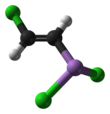Lewisite
It was once manufactured in the U.S., Japan, Germany[2] and the Soviet Union[3] for use as a chemical weapon, acting as a vesicant (blister agent) and lung irritant.
Although the substance is colorless and odorless in its pure form, impure samples of lewisite are a yellow, brown, violet-black, green, or amber oily liquid with a distinctive odor that has been described as similar to geraniums.
[7] In a 1959 paper regarding the development of a batch process for lewisite synthesis, Gordon Jarman of the United States Army Chemical Warfare Laboratories said: The manufacture can be one of the easiest and most economical in the metal-organic field, and it is regretted that no one has ever found any use for the compound.
[7]While the compound itself has no useful application, a 1993 report from the US Defense Nuclear Agency detailed attempts by Russian chemists in "exploring processes for the conversion of these agents to marketable products", including the extraction of high-purity arsenic for use in semiconductor doping (as gallium arsenide).
The report, however, concluded that "the engineering and scale up of the process to a production level may be prohibitively difficult" and that "unless other metallic impurities which are likely to be found in Lewisite are removed, the high purity required for chip application may require additional steps", noting that worldwide demand for arsenic compounds (already declining at the time) was projected to shrink further, and that the proposed economics of the conversion process did not align with then-current prices for gallium arsenide.
[5] Inhalation, the most common route of exposure, causes burning pain and irritation throughout the respiratory tract, nosebleed (epistaxis), laryngitis, sneezing, coughing, vomiting, difficult breathing (dyspnea), and in severe cases of exposure, can cause fatal pulmonary edema, pneumonitis, or respiratory failure.
[4][5] The results of eye exposure can range from stinging, burning pain and strong irritation to blistering and scarring of the cornea, along with blepharospasm, lacrimation, and edema of the eyelids and periorbital area.
It can also cause long-term illnesses or permanent damage to organs, depending on where the exposure has occurred, including conjunctivitis, aversion to light (photophobia), visual impairment, double vision (diplopia), tearing (lacrimation), dry mucous membranes, garlic breath, burning pain in the nose and mouth, toxic encephalopathy, peripheral neuropathy, seizures, nausea, vomiting, chronic obstructive pulmonary disease (COPD), bronchitis, dermatitis, skin ulcers, basal cell carcinoma, and squamous cell carcinoma.
[14] Experimental and computational studies both find that the trans-2-chloro isomer is the most stable, and that the carbon–arsenic bond has a conformation in which the lone pair on the arsenic is approximately aligned with the vinyl group.
[18][full citation needed] Exposure to the resulting compound made Nieuwland so ill he was hospitalized for several days.
[19] In 1918, John Griffin, Julius Arthur Nieuwland's thesis advisor, drew Lewis's attention to Nieuwland's thesis at Maloney Hall, a chemical laboratory at The Catholic University of America, Washington D.C.[20] Lewis then attempted to purify the compound through distillation but found that the mixture exploded on heating until it was washed with hydrochloric acid.
Field trials with lewisite during World War II demonstrated that casualty concentrations were not achievable under high humidity, due to the rate of hydrolysis and the characteristic odor of the chemical, and the formation of tears forced troops to don masks and avoid contaminated areas.
[citation needed] The United States produced about 20,000 tons of lewisite, keeping it on hand primarily as an antifreeze for mustard gas, or to penetrate protective clothing in special situations.
[25] The last remaining U.S. stockpiles at the Deseret Chemical Depot located outside Salt Lake City, Utah were destroyed in January 2012.
[27] In 2001, lewisite was found in a World War I weapons dump in Washington, D.C.[28] In July 2023 a spokesman of the Armed Forces of Ukraine claimed that during the battle of Bakhmut a Russian artillery attack against Ukrainian forces had included lewisite, causing symptoms of nausea, vomiting and in some cases loss of consciousness.





